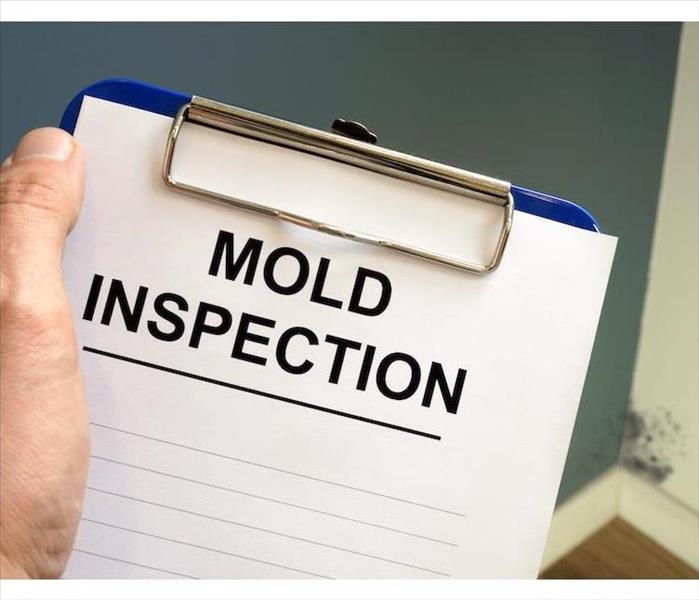Does SERVPRO Test for Specific Types of Mold during Office Mold Inspection?
10/16/2020 (Permalink)
 If mold is left unchecked, it can spread very quickly. Contact our IICRC certified mold damage remediation team for an assessment today.
If mold is left unchecked, it can spread very quickly. Contact our IICRC certified mold damage remediation team for an assessment today.
Dover Entrepreneurs are Concerned about Mold Inspection Results.
Building maintenance can eat up a large chunk of any Dover business’ budget. Building maintenance includes fixing leaking pipes or dripping faucets, window cleaning, clearing out gutters, and even employing a regular cleaning crew to keep the office spick and span.
Dealing with fungus is an essential part of building maintenance. Mold inspection in Dover companies helps keep buildings free from mold and its potentially damaging effects:
- Mold looks unsightly and creates an unpleasant working environment
- Mold can cause health effects
- Mold can damage everything from office furniture to walls, ceilings, and insulation
Mold spreads rapidly throughout a building. The microscopic spores quickly become airborne, travel on employees’ clothes, or get into the HVAC system. That is why it's important to call SERVPRO of Dover / Stillwater if you suspect fungus in your office. If you do not see visible signs but can smell a moldy smell, that is still reason enough to call us. We will get back in touch within an hour to arrange a site visit, and our expert technicians will assess the situation and let you know the best course of action.
It is better to get an expert opinion than to run the risk of mold spreading and causing more costly problems further down the line. Meantime, encourage your staff to stay away from the mold and do not attempt to clean it.
What sort of mold grows in an office?
Many common types of fungus thrive inside commercial buildings. Here are five of the most common – and where to look for them.
- Trichoderma is a green and white woolly-looking mold. It typically grows on wet surfaces, including damp wallpaper and carpet and other fabrics such as upholstery or drapes. You can also find it in HVAC systems that have a buildup of moisture.
- Mucor grows in thick white or gray patches. Mucor mostly thrives around air vents and HVAC systems that have a sheen of condensation to provide moisture.
- Cladosporium is a green or brownish mold with a suede-like look. Cladosporium grows in fabrics such as carpets or upholstery, and can also hide under floorboards.
- Alternaria is a prevalent type of indoor mold, which is deep green or brown, with velvety-looking growth. It thrives in damp areas, so look for it under sinks or around faucets.
- Aureobasidium is a pink or brownish mold, which sometimes darkens to nearly black as it ages. It is most commonly found hiding behind wallpaper, and also grows on painted or wooden surfaces.
Of course, you should also be on the lookout for Stachybotrys. This is what people usually mean when they talk about “black mold.” Stachybotrys appear as black or deep green patches of mold with a slimy texture. It thrives in moist, damp areas, and is particularly likely to grow on paper (including wallpaper), cardboard, and wood.
Does SERVPRO test for specific mold types?
In most cases, we do not need to send spores away for sampling and confirmation of the mold type. The mold remediation process is the same for all fungus types, so knowing the specific species is not usually necessary. However, if your office has extensive mold growth, it might be required to test the spores to help figure out why the problem is so bad. A third party expert carries out mold testing – if testing is needed, SERVPRO can find and liaise with a mold testing company on your behalf.
What tests will SERVPRO carry out?
As discussed above, some mold species are hard to spot and might hide behind wallpaper or floorboards. That is why visual inspection alone is not enough. We use a range of moisture meters and other instruments to measure moisture in carpets and walls, and measure humidity. Our tests give a clear indication of the extent and pattern of both mold and water, which is a vital component of mold propagation.
What happens after mold inspection?
After inspection, SERVPRO technicians carry out mold remediation. We:
- Set up containment to keep the spores from escaping
- Scrub, wipe, and vacuum away visible mold
- Use media blasting if appropriate, for a fast and effective result
- Use air movers and dehumidifiers to dry the area
Drying is vital because if there is still moisture, the mold can quickly re-grow. We also deodorize your office to leave it fresh. If you are concerned about mold in carpets, drapes, or office furniture, we can deal with cleaning and replacing these as necessary. We can also assist with re-painting, hanging new wallpaper, and fixing any structural damage caused by the fungus.
If you need mold remediation that leaves your premises Certified: SERVPRO Cleaned, call SERVPRO of Dover / Stillwater at (973) 810-2825.






 24/7 Emergency Service
24/7 Emergency Service